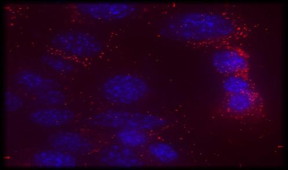Home > Press > Tiny bubbles in our body could fight cancer better than chemo
 |
| Bubbly extracellular vesicles (in red), carrying a combination of therapeutic drugs and genes, target breast cancer cells (in blue) in mice. Courtesy photo. |
Abstract:
Healthy cells in our body release nano-sized bubbles that transfer genetic material such as DNA and RNA to other cells. It’s your DNA that stores the important information necessary for RNA to produce proteins and make sure they act accordingly.
Tiny bubbles in our body could fight cancer better than chemo
East Lansing, MI | Posted on September 18th, 2019
These bubbly extracellular vesicles could become mini treatment transporters, carrying a combination of therapeutic drugs and genes that target cancer cells and kill them, according to new research from Michigan State University and Stanford University.
The study, which focused on breast cancer cells in mice, is published in Molecular Cancer Therapeutics.
“What we’ve done is improve a therapeutic approach to delivering enzyme-producing genes that can convert certain drugs into toxic agents and target tumors,” said Masamitsu Kanada, lead author and an assistant professor of pharmacology and toxicology in MSU’s Institute for Quantitative Health Science and Engineering.
These drugs, or prodrugs, start out as inactive compounds. But once they metabolize in the body, they’re immediately activated and can get to work on fighting everything from cancer to headaches. Aspirin is an example of a common prodrug.
In this case, researchers used extracellular vesicles, or EVs, to deliver the enzyme-producing genes that could activate a prodrug combination therapy of ganciclovir and CB1954 in breast cancer cells. Minicircle DNA and regular plasmid – two different gene vectors that act as additional delivery mechanisms for DNA – were loaded into the vesicles to see which was better at helping transport treatment. This is known as a gene-directed enzyme, prodrug therapy.
They found that the minicircle DNA was 14 times more effective at delivery and even more successful at killing cancerous tumors.
“Interestingly, the plasmid delivery method didn’t show any tumor cell killing,” Kanada said. “Yet the minicircle DNA-based therapy killed more than half of the breast cancer cells in the mice.”
According to Kanada, this new approach could effectively become a better cancer treatment option than chemotherapy down the road.
“Conventional chemotherapy isn’t able to differentiate between tumors and normal tissue, so it attacks it all,” Kanada said. “This non-specificity can cause severe side effects and insufficient drug concentration in tumors.”
With EVs, treatment can be targeted and because of their compatibility with the human body, this type of delivery could minimize the risk of unwanted immune responses that can come with other gene therapies.
“If EVs prove to be effective in humans, it would be an ideal platform for gene delivery and it could be used in humans sooner than we expect,” Kanada said.
A phase-one clinical trial, separate from Kanada’s work, is set to start soon in the U.S. and will use EVs and a type of therapeutic RNA molecule for the treatment of metastatic pancreatic cancer.
While that trial moves forward, Kanada and his team will continue to further engineer and test EVs, improving their effectiveness and safety so using them as a cancer-fighting gene therapy in humans becomes reality.
###
The study was funded in part by the National Institutes of Health.
####
About Michigan State University
Michigan State University has been working to advance the common good in uncommon ways for more than 160 years. One of the top research universities in the world, MSU focuses its vast resources on creating solutions to some of the world’s most pressing challenges, while providing life-changing opportunities to a diverse and inclusive academic community through more than 200 programs of study in 17 degree-granting colleges.
For more information, please click here
Contacts:
Sarina Gleason
517-355-9742
Copyright © Michigan State University
If you have a comment, please Contact us.
Issuers of news releases, not 7th Wave, Inc. or Nanotechnology Now, are solely responsible for the accuracy of the content.
News and information
![]() Trapping and moving tiny particles using light September 24th, 2019
Trapping and moving tiny particles using light September 24th, 2019
![]() Tiny, biocompatible laser could function inside living tissues: Nanolaser has potential to treat neurological disorders or sense disease biomarkers September 23rd, 2019
Tiny, biocompatible laser could function inside living tissues: Nanolaser has potential to treat neurological disorders or sense disease biomarkers September 23rd, 2019
![]() ‘Nanochains’ could increase battery capacity, cut charging time September 20th, 2019
‘Nanochains’ could increase battery capacity, cut charging time September 20th, 2019
![]() Nano bulb lights novel path: Rice University engineers create tunable, nanoscale, incandescent light source September 20th, 2019
Nano bulb lights novel path: Rice University engineers create tunable, nanoscale, incandescent light source September 20th, 2019
Cancer
![]() Nanotherapy: the controlled delivery of chemotherapeutics to fight cancer stem cells September 6th, 2019
Nanotherapy: the controlled delivery of chemotherapeutics to fight cancer stem cells September 6th, 2019
Govt.-Legislation/Regulation/Funding/Policy
![]() Nano bulb lights novel path: Rice University engineers create tunable, nanoscale, incandescent light source September 20th, 2019
Nano bulb lights novel path: Rice University engineers create tunable, nanoscale, incandescent light source September 20th, 2019
![]() Keystone Nano Announces FDA Approval of Investigational New Drug Application for Ceraxa for the Treatment of Acute Myeloid Leukemia September 18th, 2019
Keystone Nano Announces FDA Approval of Investigational New Drug Application for Ceraxa for the Treatment of Acute Myeloid Leukemia September 18th, 2019
![]() A Quantum Leap: $25M grant makes UC Santa Barbara home to the nations first NSF-funded Quantum Foundry, a center for development of materials for quantum information-based technologies September 16th, 2019
A Quantum Leap: $25M grant makes UC Santa Barbara home to the nations first NSF-funded Quantum Foundry, a center for development of materials for quantum information-based technologies September 16th, 2019
![]() One-atom switch supercharges fluorescent dyes: Rice University lab discovers simple technique to make biocompatible ‘turn-on’ dyes September 13th, 2019
One-atom switch supercharges fluorescent dyes: Rice University lab discovers simple technique to make biocompatible ‘turn-on’ dyes September 13th, 2019
Possible Futures
![]() Trapping and moving tiny particles using light September 24th, 2019
Trapping and moving tiny particles using light September 24th, 2019
![]() Tiny, biocompatible laser could function inside living tissues: Nanolaser has potential to treat neurological disorders or sense disease biomarkers September 23rd, 2019
Tiny, biocompatible laser could function inside living tissues: Nanolaser has potential to treat neurological disorders or sense disease biomarkers September 23rd, 2019
![]() ‘Nanochains’ could increase battery capacity, cut charging time September 20th, 2019
‘Nanochains’ could increase battery capacity, cut charging time September 20th, 2019
Nanomedicine
![]() Tiny, biocompatible laser could function inside living tissues: Nanolaser has potential to treat neurological disorders or sense disease biomarkers September 23rd, 2019
Tiny, biocompatible laser could function inside living tissues: Nanolaser has potential to treat neurological disorders or sense disease biomarkers September 23rd, 2019
![]() Keystone Nano Announces FDA Approval of Investigational New Drug Application for Ceraxa for the Treatment of Acute Myeloid Leukemia September 18th, 2019
Keystone Nano Announces FDA Approval of Investigational New Drug Application for Ceraxa for the Treatment of Acute Myeloid Leukemia September 18th, 2019
![]() One-atom switch supercharges fluorescent dyes: Rice University lab discovers simple technique to make biocompatible ‘turn-on’ dyes September 13th, 2019
One-atom switch supercharges fluorescent dyes: Rice University lab discovers simple technique to make biocompatible ‘turn-on’ dyes September 13th, 2019
Discoveries
![]() Trapping and moving tiny particles using light September 24th, 2019
Trapping and moving tiny particles using light September 24th, 2019
![]() Tiny, biocompatible laser could function inside living tissues: Nanolaser has potential to treat neurological disorders or sense disease biomarkers September 23rd, 2019
Tiny, biocompatible laser could function inside living tissues: Nanolaser has potential to treat neurological disorders or sense disease biomarkers September 23rd, 2019
![]() ‘Nanochains’ could increase battery capacity, cut charging time September 20th, 2019
‘Nanochains’ could increase battery capacity, cut charging time September 20th, 2019
Announcements
![]() Trapping and moving tiny particles using light September 24th, 2019
Trapping and moving tiny particles using light September 24th, 2019
![]() Tiny, biocompatible laser could function inside living tissues: Nanolaser has potential to treat neurological disorders or sense disease biomarkers September 23rd, 2019
Tiny, biocompatible laser could function inside living tissues: Nanolaser has potential to treat neurological disorders or sense disease biomarkers September 23rd, 2019
![]() ‘Nanochains’ could increase battery capacity, cut charging time September 20th, 2019
‘Nanochains’ could increase battery capacity, cut charging time September 20th, 2019
Interviews/Book Reviews/Essays/Reports/Podcasts/Journals/White papers
![]() Trapping and moving tiny particles using light September 24th, 2019
Trapping and moving tiny particles using light September 24th, 2019
![]() Tiny, biocompatible laser could function inside living tissues: Nanolaser has potential to treat neurological disorders or sense disease biomarkers September 23rd, 2019
Tiny, biocompatible laser could function inside living tissues: Nanolaser has potential to treat neurological disorders or sense disease biomarkers September 23rd, 2019
![]() ‘Nanochains’ could increase battery capacity, cut charging time September 20th, 2019
‘Nanochains’ could increase battery capacity, cut charging time September 20th, 2019
Nanobiotechnology
![]() Keystone Nano Announces FDA Approval of Investigational New Drug Application for Ceraxa for the Treatment of Acute Myeloid Leukemia September 18th, 2019
Keystone Nano Announces FDA Approval of Investigational New Drug Application for Ceraxa for the Treatment of Acute Myeloid Leukemia September 18th, 2019
![]() Inspired by natural signals in living cells, researchers design artificial gas detector: Tiny box puts itself together and glows September 13th, 2019
Inspired by natural signals in living cells, researchers design artificial gas detector: Tiny box puts itself together and glows September 13th, 2019
![]() One-atom switch supercharges fluorescent dyes: Rice University lab discovers simple technique to make biocompatible ‘turn-on’ dyes September 13th, 2019
One-atom switch supercharges fluorescent dyes: Rice University lab discovers simple technique to make biocompatible ‘turn-on’ dyes September 13th, 2019










